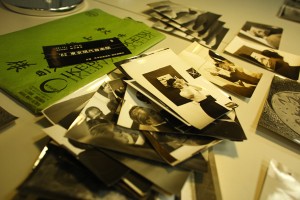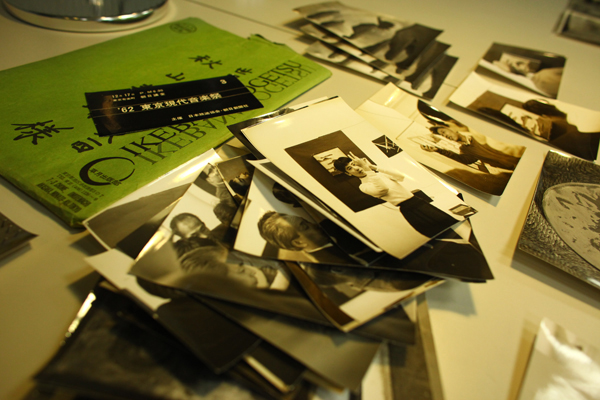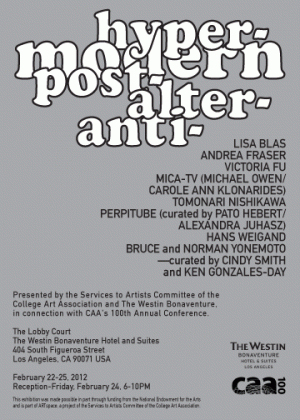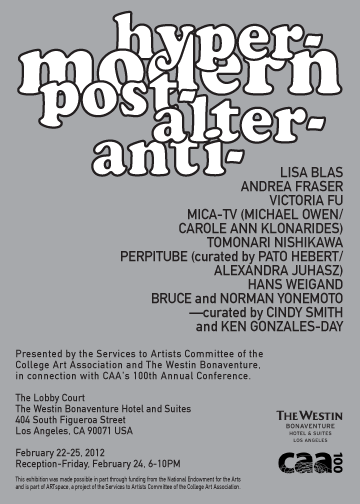Posts from the ‘social networking’ Category
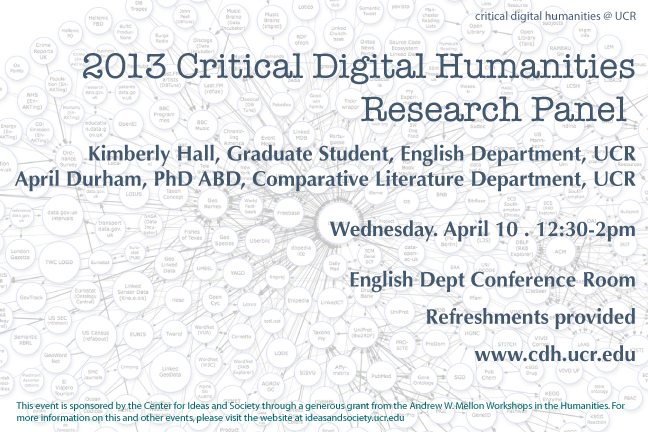 The Critical Digital Humanities presents a CDH research panel with presentations by April Durham and Kimberly Hall. They will present drafts of recent research in digital humanities for discussion and comment.
The Critical Digital Humanities presents a CDH research panel with presentations by April Durham and Kimberly Hall. They will present drafts of recent research in digital humanities for discussion and comment.
Wednesday . April 10 . 12:30 – 2
English Department Conference Room
Refreshments will be served.
The Museum of Modern Art launches post, a participatory digital platform for global research
February 20th, 2013
April Durham
The Museum of Modern Art launches post,
a participatory digital platform for global research
post is an open forum for sharing research and circulating works in progress, offering a platform for critical response and an instrument for increasing expertise through exposure to ideas from around the globe. It is a place for conversation and debate, for building a nuanced understanding of the histories that shape our present. As a Web platform, post provides an alternative to the model of a unified art-historical narrative. post instead allows a malleable, layered understanding of multiple notions of modernity to emerge over time, as more people from more places participate.
Emerging out of research undertaken at MoMA, post develops a network of partners and users whose complementary research and concerns will shape future approaches and content. Starting with a specific thematic focus, the site regularly releases essays, interviews, reports, reflections, archival materials, and artists’ commissions, ensuring that new voices are constantly entering the discussion. The site is designed to encourage active participation; users and institutional partners are encouraged to upload their own findings and share their questions, together gaining broader exposure and expertise. In time, and depending upon the interest of the partners, post will broaden its focus.
Committed to investigating artistic practices that have historically been overlooked in MoMA’s collection and exhibitions, post initially explores sites of experimental practices in regions that are the focus of C-MAP research: East Asia, Central and Eastern Europe, and Latin America and the Caribbean. Upon its launch, post will present its first case study, in partnership with Keio University Art Center, featuring the archival materials of Sogetsu Art Center, an epicenter of avant-garde artistic experiments in Tokyo in the 1960s that hosted an exciting, rapid-fire series of programs in experimental music, jazz, and cinema. The initial presentation features essays, interviews, and works by artists related to Sogetsu Art Center—Shiomi Mieko, Yokoo Tadanori, Matsumoto Toshio, andYamaguchi Katsuhiro—and artists who have been the subject of C-MAP research—Geta Brătescu, Chim↑Pom, and Jikken Kobo, among others.
About C-MAP
C-MAP research questions the judgments that grow out of the assumption that artistic modernism is or was determined solely by Western European and North American narratives of early-20th-century avant-gardes. The aim of C-MAP is to understand more fully the historical imperatives and changing conditions of transnational networks of artistic practice, and to seek verbal and material accounts of histories that are little known outside their countries of origin. C-MAP forges new relationships and partnerships and undertakes collaborative research in order to develop new expertise, share what has been learned, and, ultimately, inform the development of exhibitions, publications, educational programs, and MoMA’s collection for the benefit of scholars, curators, educators, students, critics, artists, and the general public.
The Museum of Modern Art’s Contemporary and Modern Art Perspectives in a Global Age Initiative (C-MAP) is supported by The Andrew W. Mellon Foundation and The International Council of The Museum of Modern Art.
Additional funding is provided by Patricia Phelps de Cisneros, Adriana Cisneros de Griffin, and Marlene Hess.
post was designed and developed by TC Labs. Creative direction by Caleb Waldorf.
 Digital Labor: The Internet as Playground and Factory
Digital Labor: The Internet as Playground and Factory
Edited by Trebor Scholz
Digital Labor asks whether life on the internet is mostly work, or play. We tweet, we tag photos, we link, we review books, we comment on blogs, we remix media, and we upload video to create much of the content that makes up the web. And large corporations profit on our online activity by tracking our interests, affiliations, and habits—and then collecting and selling the data. What is the nature of this interactive ‘labor’ and the new forms of digital sociality that it brings into being? The international, interdisciplinary contributors to Digital Labor suggest that there is no longer a clear divide between ‘the personal’ and ‘work,’ as every aspect of life drives the digital economy: sexual desire, boredom, friendship—and all become fodder for speculative profit. They argue that we are living in a total labor society and the way in which we are commoditized, racialized, and engendered is profoundly and disturbingly normalized by the dominant discourse of digital culture. Digital Labor poses a series of questions about our digital present: How is the global crisis of capitalism linked to the hidden labor of the digital economy? How do we address that most online interaction, whether work or play, for profit or not, is taking place on corporate platforms? How can we acknowledge moments of exploitation while not eradicating optimism, inspiration, and the many instances of individual financial and political empowerment? In response to these questions, this collection offers new definitions of digital labor that address and challenge the complex, hybrid realities of the digital economy.
Introduction: Trebor Scholz Why Does Digital Labor Matter Now? I. The Shifting Sites of Labor Markets
1. Andrew Ross On the Digital Labor Question
2. Tiziana Terranova Free Labor
3. Sean Cubitt The Political Economy of Cosmopolis
4. McKenzie Wark Considerations on A Hacker Manifesto II. Interrogating Modes of Digital Labor
5. Ayhan Aytes Return of The Crowds: Mechanical Turk and Neoliberal States of Exception
6. Abigail De Kosnik Fandom as Free Labor
7. Patricia Clough The Digital, Labor and Measure Beyond Biopolitics
8. Jodi Dean Whatever Blogging III. The Violence of Participation
9. Mark Andrejevic Estranged Free Labor
10. Jonathan Beller Digitality and The Media of Dispossession
11. Lisa Nakamura Don’t Hate the Player, Hate the Game: The Racialization of Labor in World of Warcraft IV. Organizing Networks in an Age of Vulnerable Publics
12. Michel Bauwens Thesis on Digital Labor in an Emerging P2P Economy
13. Christian Fuchs Class and Exploitation on the Internet
14. Ned Rossitter and Soenke Zehle Acts of Translation: Organizing Networks as Algorithmic Technologies of the Common
LACE presents Now he’s out in public and everyone can see, a new 18 channel video installation by artist Natalie Bookchin on view 8 March – 15 April, 2012.
Now he’s out in public and everyone can see weaves together found fragments from online video diaries in which vloggers recount a series of media scandals involving African American men. The multiple stories, originally circulated and enflamed by networks of corporate media gone viral, intersect around themes of racial and class identity and explore popular attitudes, anxieties, and conflicts about race. Bookchin’s work creates a critical context for otherwise isolated and scatter-shot online voices, drawing links, making connections, and locating tropes between individual rants and responses. Where the typical viewer of online video is a single person in front of her screen, the installation produces an active social space where multiple viewers navigate through a media environment, piecing together a fragmented and layered narrative told across space and time.
A major new work by Bookchin, Now he’s out in public and everyone can see was developed over the past two and a half years and is part of a larger body of work in which Bookchin repurposes videos made and circulated online, giving new social shape and form to individual expression. This newest project is spatially and conceptually complex, weaving together many more videos, sounds, voices, narratives, and perspectives into three-dimensional space. This further evolution of form reflects and explores the mix of struggles, conflicts, and harmony in some of the critical stories we as a society are telling today about who we are, and what we aspire to be, and represents a significant step in Bookchin’s practice.
—
Our recent guest, artist Natalie Bookchin, will present a new work called “He’s Out in Public” at LACE in Hollywood. Bookchin uses the massive archive of self-expressive texts on youtube, vimeo, and other social video networking sites to render dynamic orchestrations of sociability and networked expression, exploring the problematics and possibilities of baroque public intimacy. Here are the details about the show and a link to the website with more information about the project:
Opening reception: Thursday, March 8 8-10pm . Show runs March 8 to April 15 .
LACE is located at 6522 Hollywood Blvd. Los Angeles, CA 90028 . phone 323.957.1777
More details about “He’s Out in Public”
One of the first goals of the Critical Digital Humanities (CDH) collective has been to create a space for digital collaboration. This virtual space would provide a buffer between a fully completed work and a digital draft, allowing research and experimentation while allaying fears of creative failure. However, as so often occurs with the creation of space, the first step was one of defining limitations more so than possibilities.
For most members, privacy was the primary concern. The virtual space should shield digital creations in their nascent states from the wider audience of the Internet, for on the Web it is nearly impossible to differentiate a work-in-progress from a finalized project. Such a lack of finality, rather than a weakness of the Internet, is one of its most cherished attributes. Read more
Except where otherwise noted, content on this site is licensed under a Creative Commons License.

